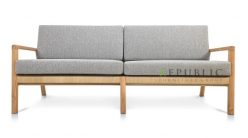Philadelphia Inquirer, PA
By Adrian Higgins
Washington Post
A birdhouse lends so much charm and color to a garden that, you could argue, it doesn’t even need feathered tenants to make us happy.
But how much more satisfying it is to have songbirds around, and to see them flitting back and forth in May with insects for their young, knowing that you lent a hand.
Now is the time to put up birdhouses, so you don’t miss the boat for the year. Spring may seem still far off, but nesting birds are beginning the search for a place to raise a new brood.
The chickadee started looking in earnest for digs in early March, says Craig Tufts, chief naturalist at the National Wildlife Federation.
Birdhouses draw the types of birds that would normally find quarters in tree cavities, Tufts says. For urban gardeners, common inhabitants include chickadees, wrens, titmice and nuthatches.
If you live close to old fields or orchards, the Eastern bluebird is likely to inhabit purpose-built houses on posts there. This bird, once waning, has made a stunning comeback in the last couple of decades, no doubt through the network of boxes built and maintained by rural nature lovers.
If you live close to parkland or golf courses, even in urban areas, Tufts says, you may have luck attracting the bluebird. The same boxes in open settings can even lure the tree swallow, “which is gorgeous, pure white underneath and metallic dark blue above.”
The Carolina wren, quick to nest and roost in cans, pots and shelving, is harder to get to live in a birdhouse, Tufts says. It’s another wren that likes to nest in a box, the house wren, that is migratory.
Various birdhouse options are available, from the ecologically savvy and ornithologically correct cedar boxes branded by the National Audubon Society, to the more wacky and singular houses made by Recycled Birdhouse Co. in Rome, Maine.
The Audubon boxes are made under license by WoodLink Ltd. of Mount Ayr, Iowa, and are available at bird-supply stores, hardware stores and independent garden centers, WoodLink president David Nylen says.
Recycled Birdhouse Co. was founded by Mark Pelletier and Curtis Brown as a workshop for disabled adults. Its birdhouses have a lot of character, not least their roofs fashioned from shingles of pine-cone scales. Many are sold as folk art and used as decorative elements in porches or hung from exposed beams.
All can go outside, some attract birds, others don’t, Pelletier says, noting: “Birding is a funny science.”
Some people delight in buying old and antique birdhouses, which can be used outdoors for their intended purpose, as long as they are weatherproofed and free of lead paint, which isn’t good for birds or humans.
Gardeners I know who place a lot of stock in bright colors have discovered the Garden Path in Portsmouth, N.H. Founded by Doug Ostrander and his wife, Anne Rugg, the company is known for its Gothic-inspired houses in gaudy but strangely harmonious shades of green, yellow, blue and turquoise, to name a few.
The post-mounted versions create interesting vertical accents in the landscape. The styles are pricey (the 7-foot-6-inch Sugarloaf retails for $395) and have spawned foreign knockoffs, Ostrander says. His are made from materials including cedar, laminated turned pine, and poplar.
Weekend carpenters, of course, can make their own birdhouses from plans available on the Internet. One source is the Cornell Lab of Ornithology (www.birds.cornell.edu/birdhouse/resources).
If you follow at least some of the rules of design and placement, and put up enough boxes by mid-March, you’re likely to get some tenants. Tufts says birds need these sanctuaries, especially as we keep yards increasingly free of organic clutter.
“We have a tendency to worry about dead and dying trees, and have them taken down,” he says.
•
If you want to draw songbirds to your garden, look for birdhouses that, ahem, fit the bill.
Comfort. Birdhouses should be at least three-quarters of an inch thick to provide insulation against cold and heat. The roof should be sloped and watertight to keep rainwater out. The base should have drainage holes to prevent rainwater from soaking nests and tenants. One side of the house should hinge open to allow old nest material to be cleaned out now, before nesting season begins. Place houses away from high-traffic areas, such as a front walk.
Safety. Houses should be hung or positioned well above the ground, at least five feet, to keep predators at bay. If you attach one to a tree, keep it away from a branch where cats might gain access. Try to place the house facing east, away from prevailing winds, and in an area of partial shade.
Customized entrance. The diameter of the hole is critical to getting the birds you want. If it’s too large, you may get starlings instead of chickadees. A chickadee entrance, for example, should be 11/8 inches across; one for nuthatches, house wrens and titmice should be 11/4 inches, and a bluebird hole, 11/2 inches. Some retailers sell metal-framed holes that screw onto the house, to prevent woodpeckers and squirrels from enlarging the entrances.
The commute. For birds, the job is to find food and a place to bathe. Shorten the search by providing birdbaths and feeders. And avoid pesticides, which kill the insects that fledglings need.





